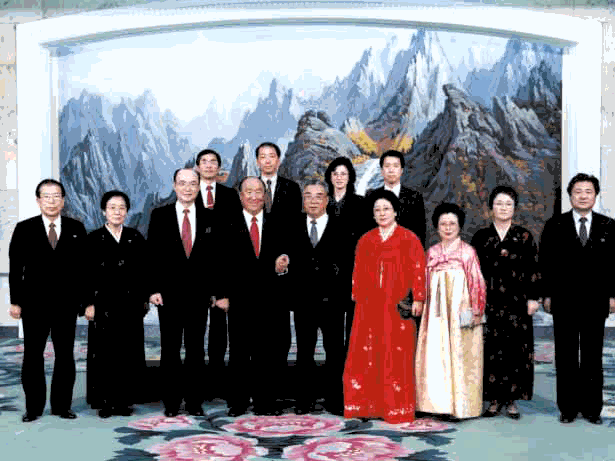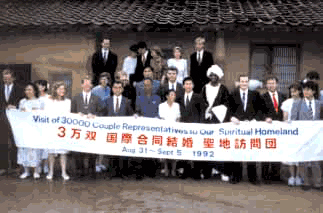
40 Years in America

|
|
40 Years in America |
|
Meeting Kim Il Sung

Rev. and Mrs. Moon and the official party meet with North Korean Premier Kim Il Sung, December, 1991.
Rev. Moon’s December 6, 1991 meeting with North Korean Premier Kim Il Sung was this missing piece. More than any other single event, it encapsulated and vindicated his life’s work. As one church account noted, it represented a "coming full circle to the place of his birth, his upbringing and the revelation which sparked...[his] course." The meeting encapsulated his life’s work because it had taken him more than four decades and the expenditure of vast resources in innumerable initiatives to obtain an invitation to visit from the government of North Korea. It also encapsulated his life’s work because in this instance, as in so many others, he was forced to swallow resentment. In a statement issued in Beijing, China following his return, he stated,
No one can claim more justification than I for harboring feelings of ill will against North Korea. I received severe persecution from the current government of North Korea because of my position as a religious leader and my unswerving anticommunist principles. I was tortured harshly and then imprisoned for nearly three years in a labor camp. There I witnessed the deaths of many who also had been imprisoned without cause....
Now, I have visited North Korea in my position as the founder of the Unification Church and in the spirit of True Love. True Love is love that loves even that which cannot be loved....
As I set foot in Pyongyang, my heart was as clear as the autumn sky. I did not feel that I was entering the house of my enemy, but rather that I was returning to my hometown to visit the house of my brother. I carried with me to North Korea the principle that I have always lived by, that is, to forgive, love and unite.
The meeting vindicated his life’s work because he turned a former enemy into a friend. It wasn’t easy. The North Koreans, predictably, subjected Rev. Moon to a variety of intimidation tactics and "tests" during his visit. There also were competing pulls from immediate family members whom he had not seen for more than four decades. However, he was there "to save the entire twenty-three million people in North Korea" and refused to be distracted from his "official mission." Beyond that, Rev. Moon’s audacity in asserting his own supreme role in "the unified Korean peninsula" intrigued Kim Il Sung and the two attained a surprising level of intimacy in their meeting.
Originally, Rev. Moon expected to go to North Korea in much the same fashion that he went to the Soviet Union, accompanied by numerous former heads of state and those attending one or more movement-sponsored conferences. However, North Korea approved plans for his visit suddenly in November 1991, and there was only time to assemble some thirty additional people, including a camera crew, The Washington Times reporters, and the heads of several movement-related organizations. This group assembled in Beijing, China on November 30, 1991. There, at the last moment, the North Korean government cut everyone off the list except Rev. and Mrs. Moon, Dr. and Mrs. Bo Hi Pak and four support staff who left for Pyongyang that day on a charter plane the North Koreans sent. With very little support and few people in his party, security was a concern from the beginning. Another difference between the North Korea trip and his earlier visit to Moscow was that while Marxism had lost much of its appeal in the Soviet Union, there were still true believers and enthusiasm for Kim Il Sung’s Juche ideology, particularly among government officials. A third difference was that while the Soviets were unfailingly polite and determined to make a success of the meetings, North Korean officials attempted to block Rev. Moon’s access to Kim Il Sung and issued at least one thinly veiled threat. Rev. Moon addressed these problems by being more intractable and unpredictable than the North Koreans. Of course, he was a native North Korean.
Nevertheless, even they were shocked by the manner and extent to which he criticized their ideology. Besides pounding on them, saying "Juche ideology is not going to work...the world is not this small.... You people are in...[a] cave," Rev. Moon made several impossible proposals. In one session, he asked the deputies attending to him to speak to Kim Il Sung and recommend that he place a large announcement in the North Korean newspaper instructing that the 30-40,000 spies and agents in the South surrender to Rev. Moon and be instructed in his head-wing ideology. In another session, Rev. Moon stated that he had to be the initiator and leader of reunification efforts, with Kim Il Sung and Roh Tae Woo of South Korea working as deputies under him.

Representative of the 30,000- couples blessing visit Rev. Moon’s birthplace in North Korea.
Ironically, the situation was saved by North Korea’s ubiquitous secret police and by Kim Il Sung himself. The secret police, who weren’t very secretive, recorded all proceedings and relayed complete information to the Great Leader. For his own part, Kim Il Sung directed that Rev. Moon’s speech at an opening banquet be published in North Korea’s only newspaper, Rodong Shinmun, and it was, word-for-word, including all references to "God." He also overruled his subordinates and insisted that he not only wanted to meet Rev. Moon but that he wanted "to have lunch with him as well." According to Dr. Pak, "The big man recognized the big man." A further irony was that Kim Il Sung chose to meet Rev. Moon at his Hamheung palace, about one hundred and fifty miles from Pyongyang, near Hungnam. In fact, the route from the state guesthouse to Kim Il Sung’s residence passed right by the Hungnam prison and fertilizer plant where Rev. Moon had been imprisoned for two years and eight months from 1948-50. Dr. Pak speculated that Kim Il Sung’s inviting Rev. Moon to Hungnam was a symbolic apology for his earlier mistreatment.
The North Korean officials who had dealt with Rev. Moon were fearful of a disastrous encounter. However, their fears were misplaced. On meeting, they gave one another "a big bear hug" and during their private one-and-a-half hour conference, Rev. Moon was a model of decorum, cordially presenting his message and ideas for the reunification of Korea. Reportedly, Kim Il Sung initiated applause and said "Thank you" three times. They exchanged hunting and fishing stories during the two-and-a-half-hour luncheon and afterwards strolled hand-in-hand down a long hallway for official pictures. According to one church account, there was some hand twisting as to whose hand was positioned on top. Nevertheless, the Pyongyang paper carried, across its front page, a large photo of them both, holding hands with big smiles on their faces, something that North Korea experts regarded as extraordinary. Later, the Segye Ilbo carried the same photograph. Kim Il Sung reportedly requested Rev. Moon to arrange a meeting with President Bush. He also offered Rev. Moon first rights to develop North Korea’s Diamond Mountains as a tourist area. They both agreed to cooperate in establishing a place where members of separated families can meet and in facilitating the exchange of mail. Kim Il Sung told Rev. Moon that he would preserve his birthplace as a shrine and that he was welcome back any time.
For church members, the meeting between Rev. Moon and Kim Il Sung had immense symbolic and practical import. Dr. Pak explained to the American membership, "[Rev. Moon] as the universal Jacob, went to North Korea, and embraced the universal Esau." To him, the "natural subjugation of Kim Il Sung...completely fulfilled God’s dispensational history." It signified that Rev. Moon could stand in the position of a friend and brother to the leader of the world’s most totalitarian state. Because Kim Il Sung was "the only world leader whom the citizens call father," it also signified the surrender of "false parenthood." In practical terms, it would have been a contradiction for Rev. Moon to think he could emerge on the world stage without at least conditionally resolving the situation in his homeland. In this respect, the meeting was the culmination of the movement’s march to Korea. It paralleled the Moscow Rally and opened the way to more direct expressions of Rev. Moon’s messianic role.
Download entire page and pages related to it in ZIP format
Table of Contents
Information
Tparents Home